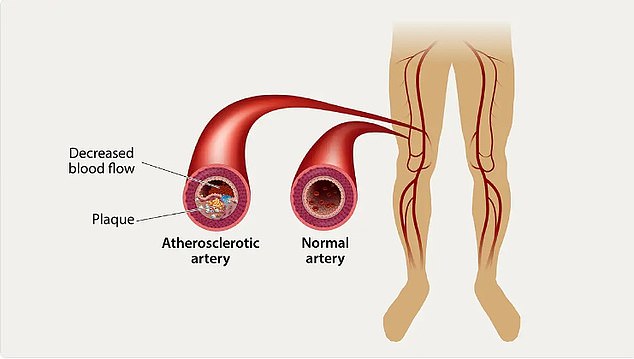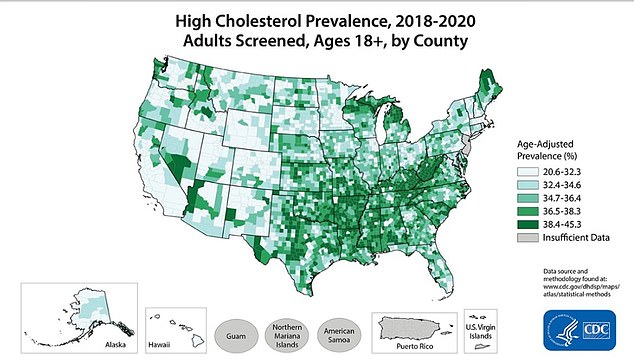An estimated 25 million Americans suffer from high cholesterol, which increases the risk of heart attacks and strokes.
But because many don’t get a blood test, four in 10 don’t completely know they have it.
Doctors are raising awareness about a sign you can pay attention to in your daily life that could tell you your risk, and it affects the legs.
The most common symptom is subtle pain in the legs during movement, according to the CDC, as well as cold, numb toes and loss of pulse in the legs.
Cholesterol is a waxy, fatty substance necessary for our body to function, but when someone has high levels, the sticky molecules can build up in blood vessels, restricting blood flow.
The map shows the concentrations of counties with the highest prevalence of cholesterol. Health officials often advise people to limit their consumption of fatty foods, which can influence the amount of cholesterol the body produces.

Howie Mandel started a campaign to raise awareness about the risks of high cholesterol called Take Cholesterol to the Heart
People with high cholesterol sometimes develop a condition called peripheral artery disease (PAD), in which small vessels in the legs or arms become blocked.
Within five years of being diagnosed with PAD, 20 percent of patients have a heart attack or stroke.
Dr. Amy Pollak, a cardiologist at the Mayo Clinic, said, “We need to ask about symptoms, treat these patients with aggressive medical therapy, and follow them more closely.”
This, Dr. Pollak said, could be crucial to reducing the number of people with heart disease, which is currently the leading cause of death in the United States.
The most common symptom, affecting 60 percent of people with PAD, is a painful, cramping or sore feeling in your arms or legs when you move or exercise, which ends when you sit down to rest.
Television personality Howie Mandel, 68, has spoken openly about his struggle with high cholesterol in hopes of raising awareness about the condition.
He said that, like many people, he ignored doctors’ warnings to control his cholesterol when he was younger.
He is now aware of how dangerous this is and urges people to manage their condition with medication and diet.
Mandel said: ‘Bad cholesterol is sticky. So you can’t say ‘I’m a few weeks away from having a heart problem’, you could be a few seconds away from having a heart problem.’
High cholesterol is incredibly common and can be caused by genetics or poor diet and exercise. Eating foods high in animal fats, such as red meat, dairy, and fried foods, can worsen cholesterol.
You can’t feel high cholesterol on its own, which means people often ignore it, but throughout life, elevated levels of this fatty substance can begin to affect your body.
One of the first changes that some might see in the legs, with PAD.
In addition to pain when walking, other signs of PAD include muscle weakness, hair loss, shiny skin, skin that is cold to the touch, decreased or absent pulses in the feet, non-healing sores on the legs, and cold, numb toes. .
People who smoke, have high blood pressure, diabetes, or are obese have a higher risk of developing PAD. After age 60, the risk of developing PAD increases.

Cholesterol can build up in small blood vessels in the legs, causing pain when walking, numbness, hair loss, shiny skin and sores, all signs of PAD. Detecting and diagnosing PAD can help someone prevent heart disease, stroke or amputation in the future, Dr. Pollak said.
Within five years of being diagnosed with PAD, about a third will die and 20 percent will have a heart attack or stroke. according to the Mayo Clinic.
If undiagnosed, people with PAD are at higher risk of losing a limb, because loss of circulation can cause tissue death, according to the American Heart Association.
Treatments include both lifestyle changes, such as controlling blood sugar, and medical changes, such as starting blood thinners or statins.
Statins are medications that can reduce the amount of cholesterol in the bloodstream.
Additionally, to prevent PAD, the CDC recommends regular cardiovascular exercise to keep blood pumping more actively through the circulatory system.
Raising awareness about this condition and the risks of high cholesterol in general is key to preventing a skyrocketing of people with heart disease in the future as the U.S. population continues to age, Pollak said.
Dr. Pollak said, “As a greater percentage of the U.S. population ages in the coming decades, progressive cardiovascular diseases like PAD will be relevant to even more people.”


